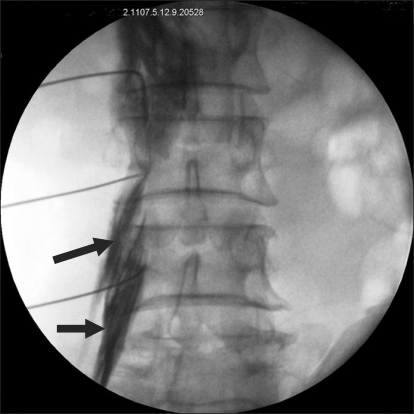Korean J Pain.
2010 Jun;23(2):131-136. 10.3344/kjp.2010.23.2.131.
Comparison of Multilevel with Single Level Injection during Lumbar Sympathetic Ganglion Block: Efficacy of Sympatholysis and Incidence of Psoas Muscle Injection
- Affiliations
-
- 1Department of Anesthesiology and Pain Medicine, Keimyung University School of Medicine, Daegu, Korea. pain1004@dsmc.or.kr
- KMID: 1770545
- DOI: http://doi.org/10.3344/kjp.2010.23.2.131
Abstract
- BACKGROUND
We prospectively evaluated the incidence and possible factors causing intramuscular injection during lumbar sympathetic ganglion block and compared the multiple needle technique to the single technique to obtain a profound and complete block effect.
METHODS
Among 83 patients, 58 patients (group A, n = 27, multiple needle technique and group B, n = 31, single needle technique) were reevaluated for the changes of skin temperature (Ts) and mean segment of longitudinal contrast spread. After injecting the contrast agent, the incidence of psoas muscle injection and the change of Ts was compared between two groups.
RESULTS
The incidence of psoas muscle injection was 21.3% (46/216) and it was associated with the level of injection (L2) significantly (chi-square = 14.773, P = 0.001). DT(post) (postblock temperature difference between ipsilateral and contralateral great toe, 4.6 +/- 2.8degrees C, 1.8 +/- 1.6degrees C, P < 0.001 for group A and B) and DT(net) (DT(post) - DT(pre), 3.9 +/- 2.7degrees C, 1.5 +/- 1.5degrees C, P < 0.001 for group A and B) was significantly higher in group A. The mean segment of longitudinal contrast spread was 8.1 +/- 0.9 for group A and 3.2 +/- 1.6 for group B (P < 0.001).
CONCLUSIONS
The LSGB at the L2 level showed the lowest incidence of psoas muscle injection of contrast. Multiple needle approach showed more significant increase of DT(net) and DT(post).
Keyword
MeSH Terms
Figure
Cited by 3 articles
-
Clinical Identification of the Vertebral Level at Which the Lumbar Sympathetic Ganglia Aggregate
Ji Won An, Jae Chul Koh, Jong Min Sun, Ju Yeon Park, Jong Bum Choi, Myung Ju Shin, Youn Woo Lee
Korean J Pain. 2016;29(2):103-109. doi: 10.3344/kjp.2016.29.2.103.Neural Ablation and Regeneration in Pain Practice
Eun Ji Choi, Yun Mi Choi, Eun Jung Jang, Ju Yeon Kim, Tae Kyun Kim, Kyung Hoon Kim
Korean J Pain. 2016;29(1):3-11. doi: 10.3344/kjp.2016.29.1.3.Successful Treatment of Severe Sympathetically Maintained Pain Following Anterior Spine Surgery
Jae Hee Woo, Hahck Soo Park
J Korean Neurosurg Soc. 2014;56(1):66-70. doi: 10.3340/jkns.2014.56.1.66.
Reference
-
1. de Oliveira R, dos Reis MP, Prado WA. The effects of early or late neurolytic sympathetic plexus block on the management of abdominal or pelvic cancer pain. Pain. 2004; 110:400–408. PMID: 15275792.
Article3. Kline MT, Yin W. Waldman SD, editor. Radiofrequency techniques in clinical practice. Interventional pain management. 2001. 2nd ed. Philadelphia: W.B. Saunders;p. 243–293.4. Datta S, Pai U. Paradiscal extraforaminal technique for lumbar sympathetic block: report of a proposed new technique utilizing a cadavar study. Pain Physician. 2004; 7:53–57. PMID: 16868611.5. Rocco AG, Palombi D, Raeke D. Anatomy of the lumbar sympathetic chain. Reg Anesth. 1995; 20:13–19. PMID: 7727322.6. Murata Y, Takahashi K, Yamagata M, Takahashi Y, Shimada Y, Moriya H. Variations in the number and position of human lumbar sympathetic ganglia and rami communicantes. Clin Anat. 2003; 16:108–113. PMID: 12589664.
Article7. Stevens RA, Stotz A, Kao TC, Powar M, Burgess S, Kleinman B. The relative increase in skin temperature after stellate ganglion block is predictive of a complete sympathectomy of the hand. Reg Anesth Pain Med. 1998; 23:266–270. PMID: 9613538.
Article8. Schmid MR, Kissling RO, Curt A, Jaschko G, Hodler J. Sympathetic skin response: Monitoring of CT-guided lumbar sympathetic blocks. Radiology. 2006; 241:595–602. PMID: 17005774.
Article9. Sayson SC, Ramamurthy S, Hoffman J. Incidence of genitofemoral nerve block during lumbar sympathetic block: comparison of two lumbar injection sites. Reg Anesth. 1997; 22:569–574. PMID: 9425975.10. Ranson CA, Burnett AF, Kerslake R, Batt ME, O'Sullivan PB. An investigation into the use of MR imaging to determine the functional cross sectional area of lumbar paraspinal muscles. Eur Spine J. 2006; 15:764–773. PMID: 15895259.
Article11. Werdehausen R, Braun S, Hermanns H, Freynhagen R, Lipfert P, Stevens MF. Uniform distribution of skin-temperature increase after different regional anesthesia techniques of the lower extremity. Reg Anesth Pain Med. 2007; 32:73–78. PMID: 17196496.
Article12. Kim YC, Bahk JH, Lee SC, Lee YW. Infrared thermographic imaging in the assessment of successful block on lumbar sympathetic ganglion. Yonsei Med J. 2003; 44:119–124. PMID: 12619184.
Article13. Stevens RA, Stotz A, Kao TC, Powar M, Burgess S, Kleinman B. The relative increase in skin temperature after stellate ganglion block is predictive of a complete sympathectomy of the hand. Reg Anesth Pain Med. 1998; 23:266–270. PMID: 9613538.
Article14. Park SY, Nahm SG, Kim YC, Lee SC. The cutoff rate of temperature to interpret the successful lumbar sympathetic block. In : The Korean Pain Society The forty nine Scientific Meeting; 2009. 11; Seoul.
- Full Text Links
- Actions
-
Cited
- CITED
-
- Close
- Share
- Similar articles
-
- A brief report on a technical description of ultrasound-guided lumbar sympathetic block
- Thoracic Sympathetic Ganglion Block for Two Patients with Thoracic Cancer Pain: A case report
- Thoracic Sympathetic Ganglion Block for a Patient with Hyperhidrosis
- The Utility of Upper Limb Sympathetic Block by Modified Injection Technique in Stellate Ganglion Block
- Neural Blockade



